Phoenix Clan Pack – Disciples of the Void
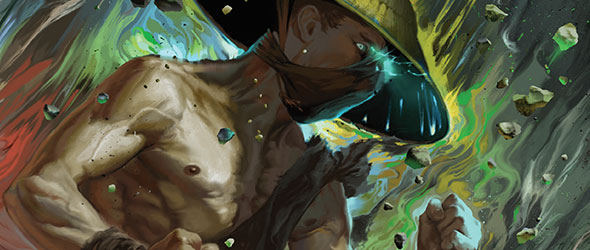
Check out our review of the Phoenix pack below. You can also check out our YouTube channel, where we talk our way through the pack (link at the end).
Kyuden Isawa
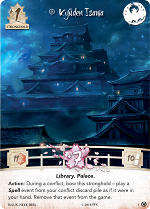
The first new stronghold to enter the game since the base set, Kyuden Isawa retains the 11 starting honor, 7 fate production, and 10 influence pool of Isawa Mori Seido, but offers only +1 bonus province strength in place of Isawa Mori Seido’s +2. More pertinently, whereas Isawa Mori Seido revolves around glory, Kyuden Isawa focuses on recursing Spell events from the Phoenix player’s discard pile. Recursion is one of the three pillars of Degenerate Power in most card games (along with resource acceleration and card draw), but Kyuden Isawa’s ability features a number of restrictions that should keep it in check: its ability is once per turn; the type of card and the timing window for playing it are specific; and the card is then removed from the game. Taking all this into account, Kyuden Isawa functions more as a form of limited card draw, albeit one with some significant tempo implications.
At the time of writing, the Spells that fit Kyuden Isawa’s profile are: Against the Waves, Benten’s Touch, Clarity of Purpose, Consumed by Five Fires (Seeker role only), Karmic Twist, Know the World, and Supernatural Storm. Of these, Against the Waves and Supernatural Storm offer the most reliably powerful conflict effects (Clarity of Purpose arguably as well), with the other options either being more situational, or involving steep opportunity costs. However, we can hazard a guess at the areas in which Kyuden Isawa might excel.
The first thing that jumps out is that both Against the Waves and Clarity of Purpose offer unbow (or don’t-bow) effects. Being able to compound and recurse these effects offers Kyuden Isawa up to twelve unbow/don’t-bow effects, creating difficulties for an opponent in terms of assignment, conflict management, and threat analysis. Repeatedly playing these unbow effects will cost fate, however – but that’s a problem Kyuden Isawa can solve by comboing Karmic Twist and Embrace the Void, or with The Path of Man (discussed below). The picture this builds is of a mid-game-oriented pressure strategy, possibly focused on towers (a ‘tower’ is a powerful character with many attachments – a literal tower of cards), using Against the Waves and Clarity of Purpose to keep those units ready, and employing Karmic Twist to either denude your opponent’s board, or to keep your towers on the table by replenishing their fate. By all accounts, a very different way of approaching deck construction in Phoenix.
As the number of Spells increases, Kyuden Isawa’s direct power, consistency, and versatility will also increase, and, given another year or so of releases, this could become an incredibly powerful stronghold.
Sanpuku Seido
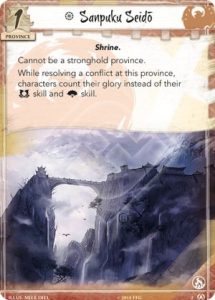
Sanpuku Seido turns glory into the determining stat for conflicts resolved at its province. Hida Kisada? Contributes 0 skill. Niten Master weighed down with attachments? Contributes 2. Dishonored Venerable Historian? Contributes 3. Since most non-champion-level characters will rarely contribute more than 2, no matter their political or military skill, their number of attachments, or honored or dishonored status, Sanpuku Seido presents unique challenges for both attacker and defender. Sanpuku Seido’s province strength of 1 means that its owner is almost obligated to send characters to defend it (unless an attacker has sent an army with a total of 0 glory), while attackers may find that Phoenix’s naturally high glory, with possible assistance from Isawa Mori Seido, means attempting to break this province could require them to assign their whole board to achieve the task.
The next point to consider is that most current conflict decks are nigh useless in determining the outcome of conflicts at this province. Conflict staples like Banzai!, and Court Games will have no impact. Bow and send-home abilities gain significant value, but the most popular ‘bow’ event, For Shame!, will require an already dishonored target, since honoring or dishonoring a character does not alter their glory. Of the twenty-four current conflict characters, fourteen have 0 glory, with Phoenix owning two of the remaining nine who have 1, leaving Bayushi Kachiko as the outlier, with 3. And since Sanpuku Seido’s ability is not triggered, it cannot be countered with Pathfinder’s Blade. One of the few ubiquitously played cards that can affect conflicts at Sanpuku Seido is Assassination, and you may be well advised to dig for one, or to save one, if you suspect you might run into this province. Phoenix players will know which cards to be wary of, however, so Assassination may not prove reliable. And once a Phoenix player has the Imperial Favor, Censure becomes an added complication.
So – is it all doom and gloom? Not necessarily. (Unless you happen to be Crab. Then it is.)
Swarming decks like Crane and Lion may be able to put enough cheap glory on the board to break Sanpuku Seido at any point in the game. Scorpion have popularly-played cards like Bayushi Kachiko, and even, in a pinch, A Fate Worse Than Death to break through, while Unicorn have surprisingly high glory of their own. If you’re Dragon or Crab, though, Sanpuku Seido could represent an almost impassable roadblock. This in itself may not be a terrible problem, but a province lineup of Sanpuku Seido, Kuroi Mori, and Public Forum could present some real headaches.
Sanpuku Seido’s 1 province strength and skill-dampening effect has the further consequence that this province acts almost like a Phoenix-only Pilgrimage. Winning or even drawing a conflict here can be incredibly difficult, and if you can’t match a Phoenix player’s defending glory, then you will lose the conflict and fail to resolve the ring. On the other hand, you can force a Phoenix player to commit characters to defend, reducing their option on attack.
So far, we’ve only talked about glory totals, but Phoenix players have another avenue to explore in leveraging Sanpuku Seido’s ability: holdings. Kanjo District, Magnificent Lighthouse, The Imperial Palace, and even Miwaku Kabe can compound the Phoenix advantage, and make Sanpuku Seido almost impregnable. With Miya Satoshi to seek out and exactly place three of those holdings, this isn’t even unlikely, and Satoshi can also fill a Phoenix player’s discard pile with Keeper Initiates, who represent free, powerful defenders.
Sanpuku Seido is a fire province, so including it means dropping either Meditations on the Tao or Night Raid from your province lineup. (We do not talk about The Blood.) Meditations is by far the preferred option in general play, but can be hit and miss. Even so, it may be preferred in certain decks over Sanpuku Seido for its sometimes highly impactful action.
Sanpuku Seido is an involved card with far-reaching implications for Phoenix deck construction, and it should see significant table time.
Support of the Phoenix

While the Phoenix get a new stronghold, all the other clans receive the Support of the Phoenix role. Support of the Phoenix provides an additional 8 influence (for a total of 18), which can only be spent on Phoenix cards. Choosing the Support of the Phoenix also means giving up your Keeper or Seeker role, meaning you will lose out on all the cards specific to the Keeper, Seeker, and various elemental roles. Furthermore, you will no longer benefit from the elemental role abilities – so no extra fate or special deck-building options for you. On the other hand, if the role your clan has been locked into does not suit your deck, and a Phoenix splash is viable, the Support of the Phoenix provides another deck-building avenue. Eventually, we will see one of these support roles for every clan.
Fire Tensai Initiate
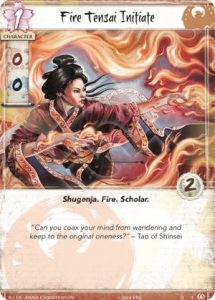
The first character in the pack, the Fire Tensai Initiate, presents something of a mystery: a blank 0/0 character for 1? Crab get the same stat line (minus 2 glory) for free in the form of Eager Scout, and the fewer comparisons made between the Initiate and Sinister Soshi or Solemn Scholar, the better. So how is this card supposed to be good? In short, I’m not sure it’s meant to be, and that playtesting showed Phoenix’s getting another good 1-cost shugenja resulted in too many consistent, overpowering starts. Given that 4-cost characters constitute Phoenix’s powerhouse slot, 1-cost characters make a perfect complement to the likes of Isawa Atsuko and Prodigy of the Waves, allowing a Phoenix player to buy a 4-coster with 2 fate and an additional character turn 1, even when going first. When one then considers Benten’s Touch, it’s not hard to envision honored, Isawa Mori Seido-boosted monster Shugenja rampaging around the board turn one. These starts are already possible, though sporadic. And, while another 1-cost Shugenja is definitely important for Phoenix, the Initiate’s non-existent stats are likely in place as a soft balance against incredibly powerful tempo starts from Phoenix.
That said, the Initiate is not a complete loss. She still enables powerful starts, she’s still a Shugenja, and her Fire trait has some value for boosting Katanas of Fire. She is also a Scholar, so Asako Tsuki can honor her, creating a 2/2 for 1, which is fair value. And any other effect that honors her, such as Asako Diplomat or the fire ring can also offer a more than reasonable return. Paradoxically, her blank stats indicate a character that may be borderline broken when Phoenix’s full lineup is taken into account. Only time and testing will tell.
Pacifist Philosopher
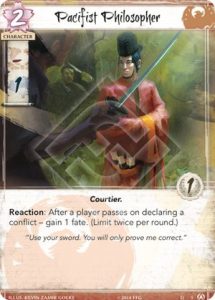
At first glance, the Pacifist Philosopher looks abysmal. With appalling stats for cost, and requiring two passed conflicts to recoup his cost, he basically demands an additional fate investment to offer any chance of profiting from his ability. However, he’s vulnerable to Assassination, against which his only defence seems likely to be an opponent’s amusement or pity. But with the addition of Wholeness of the World (below), Phoenix are now capable of preventing opponents from declaring conflicts, so, all of a sudden, there’s an opening – somewhere he might have use. Ring denial isn’t a win condition though, and there’s still the Assassination problem. It’s only when we see the Kaito Temple Protector (again, below) that things start to become clearer. The Pacifist Philosopher is a dishonor character.
One of the problems reviewing this pack is that there are a number of cards that (appear to) interact together and (appear to) create entirely new archetypes – and discussing new archetypes in depth isn’t what this article is about. Suffice it to say that the Pacifist Philosopher is a card that could very much tempt an opponent to play Assassination, as he represents potentially exceptional value under the right circumstances. Shiba Tsukune creates some of those circumstances already, by allowing you to pass your own conflicts and still resolve up to two ring effects per turn. And, as we’ll see in the review sections for Wholeness of the World and Kaito Temple Protector, Phoenix now also have ways to force and/or severely discourage opponents from declaring conflicts of their own. Dishonor makes these pieces gel, as well as offering a secondary (or primary) victory condition. Whether such an archetype is tournament-viable remains to be seen, but the apparently useless Philosopher might soon prove that a lot can be achieved by doing very little at all.
Shiba Tetsu
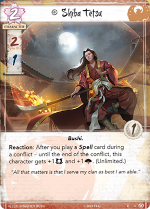
Shiba Tetsu is a quality 2-drop, comparable to many of Crane’s excellent 2-cost characters, but with a decidedly Phoenix twist. While at his best when Spells are being played as a matter of course during a conflict, his ability can also allow a player to sacrifice value for tempo by playing Spells inefficiently for skill bonuses. Given that Phoenix are generally swimming in value cards while they struggle early for tempo, this gives Tetsu a niche to occupy, while still offering further upside. He’ll be at his best in Kyuden Isawa, where the stronghold’s Spell recursion has natural synergy with his ability, but he should still perform an adequate role in Spell-heavy Isawa Mori Seido decks. At 2 cost, he is vulnerable to Assassination, but probably has to be, given that he can scale to high champion-level stats in large conflicts. Phoenix have struggled for quality tempo-oriented characters in the 2-cost range, which Tetsu goes a way toward rectifying.
Inquisitive Ishika
Phoenix have the most esoteric economy cards in the game. The Inquisitive Ishika has all-too-familiar Phoenix stats (another 0/0 against Scorp, you say?), but her stats aren’t the point. She offers potentially significant rewards for a Phoenix player who successfully navigates the invisible currents of a turn, and can end up returning a player’s investment in her – and then some. Her cost reduction crosses the most important gap in the game: reducing 1-cost conflict cards to 0, which can open up an entire hand under the right circumstances. Reducing the cost of more expensive cards may be no less impactful. Opponents will need to be wary of declaring a fire conflict if you have 1 fate available, because Display of Power is now an option. Phoenix’s weak, base-set conflict characters (Seeker of Knowledge and Ishiken Initiate) become far more impressive when they cost 1 less. And the Ishika can stack her ability, so 2 of her on board at the same time would reduce the costs of Display, Seeker, and Ishiken Initiate to 0. Clearly, with the right setup, the Inquisitive Ishika can completely alter the range of threats an opponent must account for.
Due to the specifics of her wording, both Isawa Kaede and the Seeker of Knowledge can enhance the Inquisitive Ishika’s effect, adding elements to a contested ring which can, in turn, widen the range of possible cost reductions she offers. While the Pacifist Philosopher (above) provides fate production that demands passing your own conflict opportunities (a significant sacrifice), or else cooperation from your opponent, the Inquisitive Ishika creates a web of effects that can powerfully alter the fabric of the game. The question then is whether that deck functions well enough without her.
Clearly, her ability is much easier to manage when attacking, given that her controller will have choice over the ring for a given conflict. However, Phoenix do have options on defence, where the Elemental Fury and Kuroi Mori provinces can enable the Ishika, while also denying an opponent access to a key ring. Kyuden Isawa may prefer Kuroi Mori over Shameful Display for this very reason, as well as being much more likely to benefit from the multiple spell-cost reductions the Ishika can provide.
The Inquisitive Ishika is a powerful but demanding card. I’d expect her to see most play in an almost Scorpion-style, early-pass, conflict-character-based deck, where the loss of tempo involved in recruiting her can best be offset by reactive play. She may also see use as a support piece in a Kyuden Isawa tower deck. All in all, a potential support superstar.
Fire Elemental Guard
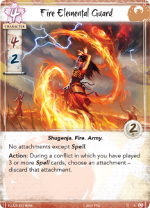
Attachment control in Phoenix? Get in there! Adding to Phoenix’s robust lineup of 4-cost shugenja comes the Fire Elemental Guard, Phoenix’s first Army. Fittingly, they are heavily slanted toward military, though not completely useless in a squabble. The meat of the character, however, lies in its ability. With the requirement of having to play three Spells in a single conflict, Fire Elemental Guard is much more likely to feature in Kyuden Isawa decks, where the stronghold’s recursion ability effectively reduces this ability’s cost by a third. The reward is one of the most coveted effect lines in the game: ‘discard that attachment.’ The Fire Elemental Guard’s contempt for attachments goes even further than that, however, and they will refuse any attachments except Spells. Somewhat despairingly, this means they are vulnerable to Cloud the Mind. (Irony, a harsh mistress.) The biggest knock against the Guard is simply the amount of competition they will face for deck slots. Prodigy of the Waves, Master of Gisei Toshi, Isawa Atsuko, and Fearsome Mystic all occupy the same cost slot, as does Miya Satoshi, who also sees regular play in Phoenix. Ultimately, Fire Elemental Guard’s inclusion is likely going to be a meta call, but its availability will never be anything less than welcome.
Kaito Temple Protector
In Kaito Temple Protector, Phoenix get a more expensive Borderlands Defender that trades its protection from being bowed on defence for some potentially huge upside. The lack of bow protection can be massaged with Clarity of Purpose (which, in turn, can be recycled by Kyuden Isawa), while the Kaito Temple Protector’s ability means that he can match even the most powerful characters an attacker can throw at you.
One thing that becomes immediately apparent is how important attachments, the Imperial Favor, and being honored can be for the Protector (events work as well, but generally represent less value due to their transience). Because the Protector sets his base skill to the target’s current value, an attachment will always give its bonus above and beyond the value resulting from the use of the Protector’s ability. For example, say a Kaito Temple Protector with a Fine Katana is defending against an Akodo Toturi who has been targeted with a Way of the Lion and a Banzai! for +4. Toturi’s military skill is 6 (base), doubled to 12 base (Way of the Lion), +4 from Banzai! for a total of 16. If the Kaito Temple Protector targets Toturi, the Protector’s skill will become 16 (base) +2 (Fine Katana), for a total of 18. If the Protector is also honored, his total after using his ability will be 16 (base), +2 (Fine Katana), +2 (honored), for a total of 20.
In the absence of being honored, or a helpful attachment, a Protector who matches the skill of a lone military or political bruiser like Hida Kisada or Kakita Yoshi will still lose the conflict – because the Protector is defending, and attackers win ties. With the +1 bonus from the Imperial Favor, however, the Protector will defeat any lone attacker unless their owner invests at least one additional card after the Protector uses its ability to match the attacking character.
When it comes to events that give skill bonuses, the most important thing to note about the Protector’s ability is that those bonuses will still apply after the Protector uses its ability. If you Banzai! your Protector, and your opponent Banzai!’s his 5-military character, when the Protector uses his ability, his military skill will be 9. This can place a significant burden of conflict-card expenditure on an attacker, and hints at the Protector’s intended home: dishonor.
This is perhaps not surprising. Two of Phoenix’s three other monks have a dishonor focus as well. The Henshin Disciple focuses on the three ‘dishonor’ rings, while Kaito Kosori focuses on leveraging the most dishonor-specific ring of all: air. Assuming Favor control, or a helpful attachment, the Kaito Temple Protector reaps the benefits of the hand constriction that dishonor typically forces on an opponent by requiring them to play cards in conflicts against the Protector, or else overcommit characters on the attack, leaving them open to honor losses from undefended provinces on defence. With hand control further supported by Magnificent Lighthouse, a dishonor player with Kaito Temple Protector can present a defence that bleeds an opponent heavily for each attack they make. By forcing attackers to commit additional resources every turn, a controlling dishonor deck can more quickly lock down an opponent, before delivering a coup-de-grâce. Attackers may also be forced to declare their military conflict first, for fear of Clarity of Purpose keeping a Protector ready and available should they first declare a political conflict.
Finally, if you have two Kaito Temple Protectors in a conflict, they can target each other, leading to some potentially ridiculous skill totals.
Isawa Tadaka
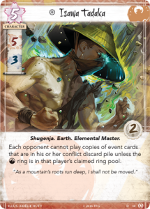
Jadin’ Raiden is back! The coolest character in the history of L5r (yes, he is; no, you’re wrong) returns to make you wish that Phoenix were forced to play Guest of Honor instead.
This is not to say that Tadaka outclasses Guest of Honor in every respect. He is very much more a mid- to late-game card, a suffocating closer as opposed to the narrower, more surgical Guest. Tadaka’s ability is limited to affecting event cards an opponent has already played. But – and here is the true power of the Master of Earth – he affects conflict and non-conflict events alike, and affects every single conflict during a turn. His ability does not require him to participate, meaning he settles across the game with the weight of a veritable land mass.
Your opponent does have an out, though – contesting and claiming the earth ring. But, given Tadaka’s presence on the board, this will be far easier said than done. As soon as Tadaka enters play, an opponent may find themselves locked out of key events, without which they may be unable to muster much, if any resistance. In addition, Phoenix have Way of the Phoenix to deny the earth ring, Know the World to steal it from the unclaimed rings pool, Display of Power to steal it from an opponent, and Wholeness of the World to keep it. So, once the landslide begins, it’s going to be hard to stop, and while Tadaka remains on the board, there is little prospect of escape. (And, as if Policy Debate wasn’t good enough already, it can now allow a Phoenix player to pre-emptively lock out a certain event, or possibly neuter two copies of an event in an opponent’s hand by discarding one of them.)
Tadaka’s mere presence in the meta may (read: should, and will) compel a number of decks to diversify their event selection or face an uphill battle should they encounter him. Cloud the Mind will take on peak importance for a number of clans, though players of Kyuden Isawa will find themselves well positioned to maneuver around Tadaka by removing their Spell events from the game via the stronghold ability, allowing them to play new copies (unless their discard pile contains two or more of the same event, in which case they will be trying to play a card that has a ‘copy’ in their discard pile, and will be forbidden from doing so). Secluded Shrine gives Phoenix players an additional out.
For tournament players, this graphic is of particular note:
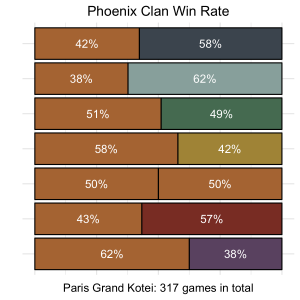
What we see immediately is that the two matchups Tadaka most affects – Crane and Scorpion – are two of Phoenix’s three worst. Not only does Tadaka rock the matchup dynamics against both of these clans, he may also afford Phoenix players the scope to better address Crab. As such, it is hard to understate Tadaka’s potential impact on Phoenix’s tournament viability – though the knock-on metagame effects of his presence may take weeks or even months to work out.
Isawa Tadaka is not just the kind of character that decides games, he is the kind that determines the shape of entire metas. Easily the single most impactful character so far designed for the game, his effect on L5R should be little short of tectonic.
Fushicho
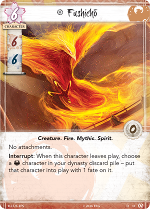
So, Charge!, huh?
Fushicho is probably never (okay – very, very rarely) going to enter play during the dynasty phase. The 6 cost is exorbitant, Fushicho doesn’t really match up to any of the champions in terms of on-board impact, and you want as much value as you can muster, given the opportunity costs of including this in your deck in the first place. Charge! suggests itself immediately, so if you see an opponent’s Fushicho flip, prepare yourself.
The no-attachments clause is a powerful benefit, meaning Fushicho’s ability is almost guaranteed to go off, barring Oni Mask interference. And, given that Phoenix decks are heavily event-based, being unable to attach cards to an already imposing 6/6 should represent few issues. This effectively turn Fushicho into a giant hammer that lands during a military conflict, and then resurrects the highest-value target in your discard pile. Because Fushicho is unique, and you cannot have two unique cards of the same name in play at the same time, and because interrupts occur before their stated trigger, a Fushicho cannot resurrect another Fushicho, thereby creating an infinite loop of absurdly-statted monster birds. Instead, you’ll hopefully be fishing out an Isawa Kaede, or a Shiba Tsukune, or maybe just a Prodigy of the Waves.
Clearly, Fushicho offers value, and would seem to be geared toward aggressive Phoenix decks. That said, it could also work as a combo piece. A card like Miya Satoshi can fill your discard pile, giving you a greater range of choice in terms of whom you resurrect. The character that Fushicho does bring back will lose their single fate token immediately, but, if that character is non-unique, a quick Karmic Twist could see them hang around a few turns longer.
So, the literal avatar of the Phoenix is a value combo card? Is there a word for something that is simultaneously kind of awesome but that also kind of hurts? No… not nostalgia. Damn. I bet there’s one in German.
Secluded Shrine
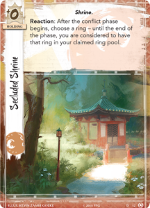
In Secluded Shrine, Phoenix are blessed with another exceptional holding. There is currently only a short list of cards that Secluded Shrine interacts with, so let’s take a look.
Henshin Disciple: Secluded Shrine will allow you to choose the option you want the Henshin to have from his air, earth, or fire bonuses. This gives the Henshin exceptional flexibility, and effectively boosts him to a 3-cost, 4-skill character in either military or politics. Or, if you’re feeling saucy, Pride can easily honor the Henshin, moving him into ‘monster stats for cheap’ territory. Phoenix have a dearth of top-quality 3-cost characters, so adding a potent option at that price point is more compelling than it might seem at first, even if he lacks Shugenja.
Ishiken Initiate: The red-headed stepchild of conflict characters has received a lot of love in this pack. Inquisitive Ishika can reduce the cost of Ishiken Initiate to a more than acceptable 1 (or even o, with more than one Ishika in play), and Secluded Shrine now pumps the Ishiken Initiate without a single ring having been contested. The possibility of dropping a 1-cost 4/4 character into a conflict warrants attention, and the Ishiken may have received enough support to become a legitimate tournament option for Phoenix (probably as a 2- or 1-of, but that’s an almost unimaginable leap from where the Ishiken was wallowing before). Much like current Scorpion iterations, Phoenix now seem more than capable of fielding a reactive, pass-early strategy, and the Ishiken is very likely to play a part in that.
Katana of Fire: Being able to start a conflict phase with the fire ring effectively ‘claimed’ means this is a base 3-military-skill weapon for 1 fate. That’s efficient.
Prodigy of the Waves: The rich get richer. Already a terror, the Prodigy can now set its sights on whatever ring it desires, not having to be shackled to picking water first almost every turn.
Solemn Scholar: Secluded Shrine transforms the Solemn Scholar from ‘sometimes useful’ into a defensive powerhouse. Having the Scholar be always ‘on’ without the need to contest and win a specific ring has such an overwhelming effect on the Scholar’s power level that either it or the Secluded Shrine must become a priority target for an opponent. However, the Scholar can help protect the Shrine, which means that players facing this combo will quickly be playing, or desperately praying for, an Assassination or Cloud the Mind.
The Prodigy and Scholar are generally both staples already, so it becomes a question of how easily and effectively the other cards can be integrated to make best value of Secluded Shrine. Splashing Crab for Rebuild can add further consistency, and Miya Satoshi can fill your dynasty discard pile with holdings to pluck out, as well as finding ‘the game-ender’: Kanjo District. Disciples of the Void has genuinely exploded the scope of Phoenix deck-building, and the possibilities are both novel and exciting.
Hida Amoro
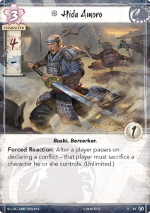
At 3 cost for 4 military skill, Hida Amoro already offers efficient stats. With a dash in political skill, he cannot participate in political conflicts, but he also cannot be targeted by Policy Debate – which is arguably an upside. And he can threaten most provinces on his own, without any additional cards. As a Bushi and Berserker, he is able to utilise the limited Bushi card pool while also benefiting from the typically Crab-only Berserker-focused cards like Crisis Breaker.
Amoro’s ability neatly dovetails with a few of Crab’s strengths. He really encourages opponents to attack, giving the Crab more opportunities to leverage their superior defensive capabilities. Crab also like to thin their opponent’s board with effects like Assassination and Way of the Crab, which Amoro can further compound. If your opponent only has one character in play and two conflicts to declare, they are going to lose that character.
On the flip side, Amoro can devastate your own board if you find yourself too far behind, but Crab have cards like Iron Mine and Reprieve to ward off his worst depredations, or to tactically forego a conflict if it suits their greater plan. Generally, cards that really reward you for being ahead and really punish you for being behind aren’t favorably looked upon, but Amoro’s ongoing impact on board dynamics will probably make him a worthy inclusion for a number of Crab decks.
Doji Shigeru
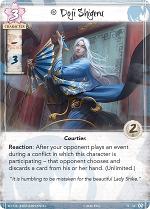
Doji Shigeru can be seen as a complement to Guest of Honor, giving Crane even more event control in conflicts. But whereas Guest of Honor locks an opponent out of playing events entirely, Shigeru tempts. On one level, this makes him strictly worse than Guest of Honor. An astute player will weigh their options, and is still allowed avenues of play by Shigeru, whereas Guest would deny them completely. But Guest of Honor won’t be around forever, while discarded cards are gone for good – and here we see the essential difference between the two. Guest of Honor is a denial card, where Doji Shigeru is a control card, and being aware of the difference will allow players to make a more informed judgement on when to include one, both, or neither.
Denial strategies are tempo-based: they seek to create negative conditions and then exploit those conditions before an opponent can adequately react. Control strategies almost always surrender tempo, but exact a heavy resource cost from their opponents, which slowly turns into an insurmountable advantage. While both Guest of Honor and Doji Shigeru may have similar outcomes – an opponent not playing events – aggressive decks will find Guest a superior addition, while slow, controlling decks may actually favor Shigeru. Crane’s card pool is not yet developed enough to make these distinctions sharp, and, because of this, Shigeru is likely to function as Guest of Honor numbers 4-6.
His dash in military skill does limit Shigeru further, but his 3 cost makes him a much cleaner early-game play compared to Guest of Honor, especially given Crane’s raft of quality 2-cost characters.
Togashi Tadakatsu

Togashi Tadakatsu sits in a weird spot for Dragon. Most Dragon dynasty decks are very similar, but the last character slot often flips between Kitsuki Yaruma and Miya Satoshi. Tadakatsu will, for many decks, simply fill this slot with a slightly better stat line for the same cost. As a unique, he does benefit from the extra fate from duplicates rule, which, due to Dragon’s proclivity for attachments, is a net benefit.
Tadakatsu’s ability changes the game in quite a radical manner, giving the defender a significant say in how the turn’s conflicts are going to play out. In most current Dragon decks, this benefits the Dragon directly, since they are more interested in destroying provinces than triggering specific rings. Tadakatsu also makes a great Charge! target. If you Charge! him into a conflict, his ability will not affect the ring you have already chosen, while your opponent’s following conflict(s) will be affected.
As a Monk, he increases Dragon’s pool of Monk dynasty characters to 6, making cards like Centipede Tattoo, High Kick, and the Mantra of Fire and Mantra of Water more reliable. Both Mantras, in fact, become incredibly reliable, because you get to choose your opponent’s ring when they attack. Tadakatsu affects the game in a completely novel way and provides a quirky but important building block for future Dragon Monk decks, and potential quality filler for current archetypes.
Ikoma Tsanuri
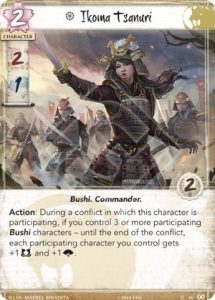
In something of a departure from the other clans’ characters in this pack, Lion get a character who doesn’t work against a Phoenix strength, but rather bolsters a strength of Lion’s own. What sets Ikoma Tsanuri apart from other Lion, however, is her ability to boost political skill. Up to now, Lion’s stat-boosting has focused exclusively on military conflicts, which has narrowed the clan and made political conflicts something a Lion player hopes more to survive than to thrive in. With Tsanuri, however, Lion can leverage their generally superior numbers to present a serious threat in at least one political conflict a turn. Tsanuri also works on both attack and defence, rather than the attack-only modality we’ve become used to, which is another welcome wrinkle. The condition to activate her ability is demanding enough – 3 Bushi isn’t a trivial requirement – but her ability affects all friendly characters in a conflict. This makes her a powerful closer when attacking a stronghold, and on turns where a Lion player is hoping to break a 3rd province and then their opponent’s stronghold, she can exert enormous pressure. As a Commander, she can also help keep Akodo Toshiro from blowing himself up if he uses his ability. At 2 cost, she fits into a swarming strategy like a hand into a glove. Lion desperately needed an equaliser for political conflicts, and Tsanuri provides them with a well-balanced but effective character who should see plenty of play.
Moto Nergui
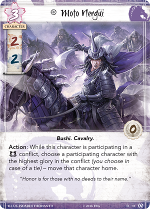
On the surface, Moto Nergui looks like a character with a simple send-home action. Send-home actions are quite poor in L5R (for the most part, #AFateWorseThanDeath), but Nergui conceals a wealth of hidden potential for forcing over- and under-commitments by an opponent, and allowing Unicorn players to overcommit while not overcommitting at all.
The key to Nergui’s flexibility is that her ability can target both your opponent’s characters and your own. This can put opponents in a quandary. If you assign a strong force to a province and they oppose strongly, Nergui can send home a key enemy character, with the result that the defender loses the conflict, and possibly the province, while having committed valuable resources. If an opponent opposes weakly or not at all, Nergui can send home one of your own characters, allowing you to take a province with minimal force, and still have characters to defend or attack. If you misjudge a conflict and send one of your characters home too early, your stronghold can move them back in. And even a bowed Nergui who hasn’t used her ability can influence a military conflict by moving in via the stronghold and sending home an opposing character. As can be seen, Nergui considerably complicates battle calculations for your opponent, significantly increasing the chances they make a mistake.
Finally, Nergui can always send herself home if she’s the only character present, making her an ideal scout if you’re trying to find nasty enemy provinces like Feast or Famine. Her stats are poor but she offers significant utility – an area in which Unicorn desperately need more support.
Kaito Kosori
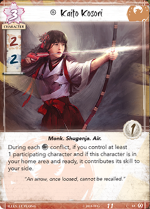
Phoenix have suffered from a decided lack of quality conflict characters, which Disciples of the Void has done much to remedy. Kaito Kosori follows the by now well-established template for a typical Phoenix card: slightly weak in isolation, very strong in concert. The designers have found a clever and pretty way to model archery: while Kosori is in your home, she contributes skill to the current conflict (although, in Kosori’s case, only if that conflict is air). This ability to project into a conflict greatly increases Kosori’s value, and a number of combos become apparent. The first is Seeker of Knowledge, whose ability will allow Kosori to project into any attacking conflict, potentially allowing Kosori to influence several conflicts a turn. With Isawa Mori Seido, an honored Kosori can throw a lot of skill around the board throughout an entire conflict phase – but any attachment that gives her a skill bonus can also multiply her value. As mentioned in the Inquisitive Ishika section (above), Elemental Fury and Kuroi Mori can help her affect the board on defence, and both Kosori and the Seeker of Knowledge are air, which means Kosori can chain into Seeker, with the Ishika reducing Kosori’s cost.
Kosori’s Monk trait is underserved by Phoenix support cards, and Phoenix only have two other Monks (the amazing Shrine Maiden, and the improving Henshin Disciple), but a Dragon splash for Mantra of Water, Mantra of Fire, or High Kick might appeal to Monk-ophiles. Kosori also has a better chance than most of remaining unbowed for an entire conflict phase, which may allow her to contest the Imperial Favor.
Kosori has a stunning, full-art promo version in the upcoming Phoenix novel.
Favor of the Kami
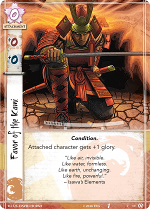
In a pack that heavily supports Kyuden Isawa, this is one of the few cards that seems overtly intended to support Isawa Mori Seido. While Favor of the Kami can be used as a further buff/debuff in concert with Isawa Mori Seido’s ability on an honored or dishonored character, the most powerful use of the card is likely to be in pushing another Phoenix character’s glory to 3, so they can contribute alongside a stronghold-buffed Haughty Magistrate. Crane and Scorpion, with their focuses of honoring and dishonoring characters, respectively, may have some interest in Favor of the Kami as well, and future combo potential shouldn’t be overlooked. Overall, a card with specific, narrow uses.
Katana of Fire

A straightforward weapon whose skill bonus can far exceed its fate-cost outlay. The more fire cards you have in play, the more military skill the Katana of Fire contributes, and having the fire ring in your claimed ring pool gives an additional +2. Each katana will buff all other katanas controlled by the same player, so seeing multiples is quite welcome. This seems most likely to see play in a Kyuden Isawa tower build, which will value attachments more than most Phoenix decks. It’s also a Spell, so Shrine Maiden fetches it, and Inquisitive Ishika can reduce its cost to 0 during fire conflicts.
Phoenix currently have the following fire cards: Fire Elemental Guard, Fushicho, Isawa Masahiro, Katana of Fire, and Fire Tensai Initiate. The only other in-clan fire cards belong to Dragon (Agasha Swordsmith and Doomed Shugenja). While Dragon and Lion currently benefit from the Seeker and Keeper of Fire roles, the role cards do not buff Katana of Fire as they are not considered to be in play.
The Path of Man
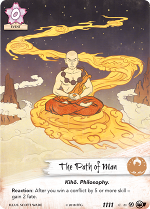
The Path of Man is L5R’s first 4-influence card, and appears fully deserving of that distinction. One of Phoenix’s issues has been that they start the game behind, due to generally weaker stats and a ‘moving parts’ design philosophy. The Path of Man event can provide a huge tempo boost, more quickly getting Phoenix back to parity, where they begin to excel.
The requirement to win a conflict by 5 or more skill may seem demanding at first, but many, if not most province breaks will see you meet that requirement on attack, and low-skill ‘pokes’ by an opponent can see you meet that condition on defence. The Path of Man is not a sure-fire bet, but it absolutely shouldn’t be, because the reward is incredibly potent. Immediate comparisons could be drawn with Embrace the Void, but where Embrace is a slower, more combo-oriented card, The Path of Man is a like bolt of lightning.
Producing 2 fate during the conflict phase from (almost) nowhere can completely alter the complexion of a game. An opponent who assumed they would face little resistance on their follow-up challenge may now find (thanks to The Path of Man and an Against the Waves) that they face a powerful, readied Shugenja unit. Potentially even worse, the 2 fate from The Path of Man could fuel a Display of Power, creating a devastating tempo swing. On top of that, The Path of Man is a Kiho, meaning it can be unearthed by Shrine Maiden, adding even further to its value, and even if an opponent knows you have a Path of Man, they will frequently be faced with a lose-lose proposition. Either commit valuable characters to a conflict they can’t be sure to win – or don’t, and allow you to play The Path of Man and open up further aggressive and defensive options. From fuelling powerful Spell effects to paying for surprise conflict characters, The Path of Man exerts even more pressure on an opponent to play a flawless game.
Wholeness of the World

Another ring-manipulation card enters the arena, but will this one have any impact? As with many Phoenix cards, it has a number of subtle interactions and combos. First, Wholeness of the World has a function similar to that of Way of the Phoenix, insofar as it denies your opponent access to a ring. But whereas Way of the Phoenix denies them that ring on the current turn, Wholeness of the World denies that ring for the following turn. On its own, this would seem to make Wholeness of the World a weaker card (and Way of the Phoenix already sees almost no play), but there are a couple of additional factors to take into account. The first and most eye-opening is that Wholeness of the World and Way of the Phoenix can combo together to deny an opponent a challenge. If a Phoenix player plays Wholeness of the World to retain a ring, and then on the following turn becomes first player, they can use Way of Phoenix to lock out another ring, which, assuming a ring is claimed in both of the Phoenix player’s challenges, will leave only a single ring that an opponent can contest. Whether this combo is good within the context of competitive play remains to be determined, but it could be the beginnings of a Phoenix conflict-choke strategy.
Next is Wholeness of the World’s Spell trait, which means Wholeness can be added to your hand by Shrine Maiden‘s ability. Potentially adding a card to your hand for free is a quality that should never be overlooked, and, on this basis alone, Wholeness of the World represents better individual value than Way of the Phoenix, despite a weaker ability.
The next factor to take into account is the combo Wholeness of the World has with Know the World. The rules reference has this to say about switching:
Switch
Some abilities use the word “switch.” In order to use such an ability, switched items must exist on each side of the switch.
Know the World’s effect has no cost (there is no dash in the text of its triggered ability), so there is no requirement to complete the switch to get Know the World’s effect. And since interrupting Know the World with Wholeness of the World does result in a change to the game state (a ring moving into your claimed pool), it seems like Know the World and Wholeness of the World can combo together to gain another claimed ring if you already have a ring in your claimed ring pool. But does this actually matter? Is this actually good? It could be, as one more part of a conflict-choke strategy, although such a strategy seems unreliable at the moment, and without a clear end-game.
Finally, Wholeness of the World allows you to retain key rings required for activating characters’ abilities, like the water ring for Prodigy of the Waves, or the earth ring for Solemn Scholar. (In fact, the list is identical to the one for Secluded Shrine, above.)
A card with many situational uses will usually have at least one available on any given turn, and Wholeness of the World fits that bill. Finally, as ring manipulation cards are beginning to combo with each other, the chances of something powerful occurring are increasing as well, so a card like Wholeness deserve extended scrutiny, if only to prepare oneself to spot more powerful combos, should they emerge in the future.
Clarity of Purpose
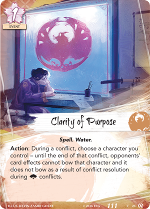
Phoenix don’t do straightforward, and Clarity of Purpose is another example. To benefit most from the part of its ability that prevents opponents’ card effects from bowing your character, Clarity of Purpose is best played on defence as a first action, before your opponent gets the opportunity to act. After all, a card that prevents you from being bowed isn’t great if you’ve been bowed already! That said, Clarity of Purpose does put pressure on defensive bow cards, most notably Mirumoto’s Fury. A player relying on Fury for defence can now no longer play a baiting game against their opponent – waiting for them to expend additional resources to break a province before playing Fury for additional gains. Now, the defending player must play Fury as their first action. If they do not, they give the attacker the opportunity to play Clarity, rendering Fury utterly useless. Mirumoto’s Fury is the gold standard in defensive cards, and Clarity of Purpose weakens it significantly, which can’t be underestimated in terms of how it could shift the metagame.
The second part of Clarity’s ability is much more clear-cut – if your character is in a political conflict, they will not bow from resolution. This skews the card heavily toward being played only in political conflicts, but beware of getting trapped in a value mindset: sometimes you need to lose a little to gain a lot.
Clarity isn’t a flashy card, but again has surprisingly subtle and important effects on the metagame. It also gives Phoenix an unparalleled suite of straightening cards, which Kyuden Isawa can best leverage. Finally, as a Spell, it can be unearthed by Shrine Maiden, who should be an essential inclusion in most, if not all Phoenix decks.
Karmic Twist

Twist by name, twisty by nature, and this, again, seemingly straightforward card can offer some powerful and unique plays. Being able to shift fate from a key enemy non-unique onto a much less important character has obvious benefits, but if that much less important character can be targeted by Assassination, you can greatly increase the value gained. Even better, you can karmically twist the knife by comboing Karmic Twist with Embrace the Void, which will allow you to move all the fate on the Embraced character to your own fate pool, a combo with results that are not entirely unlike Feast or Famine.
When played on your own characters, Karmic Twist allows you to use expendable fodder like Naive Student as mini fate freight trains – bringing the Student into play with additional fate that you can quickly transfer to a much more valuable character like a Prodigy of the Waves or Fire Elemental Guard. Or you can get trickier again and use a conflict character to bring that fate into play during a conflict, possibly stymying a powerful water ring effect that would target a key character you control. Conversely, you could use Karmic Twist during your own water challenge to strip an opponent’s out-of-conflict character of fate, setting them up to be bowed by your water ring effect. Bringing fate in via conflict characters could also be performed prior to the fate phase, giving you a pseudo-Reprieve effect (only much jankier, because Phoenix).
Phoenix is a clan of moving parts, and this tends to see them veer between spectacular success and abysmal failure. Karmic Twist greatly improves the later-game value of Embrace the Void and Assassination, while offering a performance floor that is still likely to be powerful. While somewhat situational, the big combo power of this card should guarantee it sees play, and as a Spell, it can be unearthed by Shrine Maiden, who is, by now, making a solid argument for being Phoenix’s best character.
Yogo Kikuyo
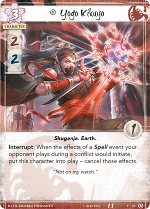
Yogo Kikuyo is a meta-dependent conflict character, who faces significant competition for slots in current Scorpion builds. Scorpion already have an excellent win rate against Phoenix, and have many other conflict characters with broader and more powerful applications. If Phoenix become a powerful metagame force and Scorpion’s matchup domination is reversed, she should absolutely see play. If not, she is more likely to feature as a splash card for another clan that does have real problems with Phoenix.
Because Kikuyo is ‘put into play,’ her fate cost is ignored when her interrupt triggers, so she will cancel a Spell and enter play as a free 2/2/1 Shugenja. As a shugenja, she can make certain important cards like Cloud the Mind more reliable, but she is still unlikely to see widespread use.
Guardian Kami
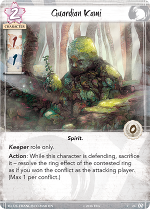
The first of two neutral conflict characters with similar abilities, the Guardian Kami is the defensively-oriented of the two, and is therefore, fittingly, a Keeper-only card. Both Guardian Kami and its sibling, Kami Unleashed, allow a player to resolve the ring effect of the contested ring as if they were the winning player. This would seem to make Guardian Kami the weaker of the two, unless you could both more accurately guess what ring an opponent will be taking, and also guarantee the importance of that ring. For these reasons, the most likely landing spot for Guardian Kami is in dishonor, where the fire and especially air rings can become hotly contested and game-determining. Dishonor decks can have surprising trouble dropping an opponent from 1 to 0, usually because the player in danger of being dishonored will prioritize the air ring. Now, a player on 1 who declares an air conflict runs the risk of being dropped to 0 before the conflict can resolve. Guardian Kami also increases the range from which a player can ‘bomb’ another out. With Guardian Kami, Display of Power, and Backhanded Compliment, an ill-advised air conflict could see a player on as much as 5 honor get dropped to 0 within a single conflict. The unreliability of Guardian Kami outside these circumstances may see it passed over in most other decks, but claiming a ring effect your opponent wants for 2 fate may be worth it under certain circumstances.
Kami Unleashed
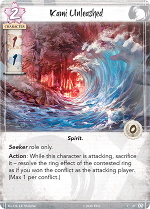
The aggressive counterpart to Guardian Kami, Kami Unleashed offers a more controllable return, since you will be able to choose the ring for the conflict in which you play this. Anyone who has faced Akodo Toturi or Doji Hotaru will know that their double-punch on ring effects can provide a devastating tempo swing, and being able to resolve a ring effect during a conflict can contribute significantly toward winning that conflict, either by honoring or dishonoring a character during a fire conflict, or by bowing or unbowing a character during a water conflict. Kami Unleashed being a conflict character further adds to its flexibility and utility, and this is a card that could see some play.
Walking the Way
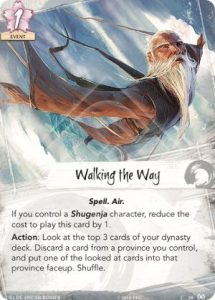
A dynasty filter card with added combo potential, Walking the Way is the sole neutral spell in Disciples of the Void. It still cares about Shugenja, but has a more moderate restriction than the usual ‘Shugenja or fuggedaboudit’ text, in this case becoming free to play for clans with a connection to the elements, and the usual ‘spell, therefore Shrine Maiden‘ boilerplate applies. The card allows you to sift down a little through your dynasty deck, and so can fix bad dynasty flips (“three Favorable Grounds and the Imperial Palace again? Fml.”), or help you hunt for a key card. It also has some combo potential with Charge!, allowing you to look for a more favorable Charge! target, or any target at all, should you lack one. Kyuden Isawa players can recurse it, allowing them dig a lot – though the recursion has to take place during the conflict phase. If you’re looking for a Charge! target, great. But, if not, it might be best to hold off until all conflicts have been resolved, so the card you’re looking for doesn’t become a target of opportunity. Decks which feature potentially powerful combo cards in their dynasty deck (e.g., Secluded Shrine) may find additional value in playing this, since the card it finds can potentially open up a whole range of other options. So, a boon to combo decks (which Phoenix inherently are), with possible value and fixing for others. Lion may benefit especially from Walking the Way.
Phoenix Splashes for Other Clans
Dragon might be interested in Kaito Kosori, to support their Monk decks. She has a strange synergy with Togashi Tadakatsu, as she either makes the air ring an less desirable choice, or potentially punishes an opponent for making you contest air. She’s also a Shugenja, which might help to make Cloud the Mind more playable. Phoenix have another excellent monk in Shrine Maiden, so Phoenix have plenty to offer Dragon Monk players.
The Path of Man could and should interest almost any clan. Its incredibly steep 4 influence cost means that even Keepers are going to have to expend almost their entire influence pool to play three, while Seekers will be limited to a maximum of two. If any single card makes an argument for playing Support of the Phoenix, this is probably it, but it comes at some cost.
Clarity of Purpose could see some play in Crane or Scorpion, or potentially anywhere, since the effect is generally applicable and quite powerful. the influence cost of 3 is demanding, however, which may act as a dissuasion.
Karmic Twist could also see play in any clan, and clans that can also field a reasonable number of Shugenja could look at the Karmic Twist/Embrace the Void combo.
The End
And that’s it! In closing, I’d just like to congratulate Brad Andres, Erik Dahlman, and Tyler Parrott on the fantastic job they’ve done with this pack. The breadth and depth of vision and implementation on display here make me genuinely excited for what other clans can look forward to in the future, and for the future of L5R in general. Thanks for reading, and take care.



10 Replies to “Phoenix Clan Pack – Disciples of the Void”
Doji Shigeru is a guy.
I’ll correct that when I edit in the remaining cards. Thanks!
No problem.
Or a marketing dude make an incorrect guess. If they are going to play games with inclusive character types reflecting current society deliberately then lets hope they do so with the Lion or Crab as that would have more ‘impact’
Ikoma Tsaburi released. Hoping for insightful feedback !
Excellent work. As always, amazing contribution to the community !
Tsanuri* Art* released …
Nice write up Justin.
Tadaka has indeed made my neck hair rise and finally calmed the tension of his expectation. Such a beautifully designed card. I still consider the ring implementation in the new L5R one of the top game mechanisms and he justifies it once more.
Also, is the 2 glory on the Fire Tensai “confirmed” or is it a speculation?
I’m still gonna try them, but maybe if it was a 3… 😛 Too much?
Hi Phineas!
Thank you, and I completely agree about Tadaka. That such an iconic Phoenix character (arguably *the* iconic Phoenix character) lives up to the burden of his stature is honestly thrilling. Agreed as well on the ring implementation. That, along with the fate mechanic, really distinguish new 5R.
The 2 glory on the Fire Tensai Initiate is confirmed. Spoiler images were posted. 3 glory would have made her a kind of Doomed Shugenja, which maybe would have been too good. Her stats are still a bit of a puzzle, but maybe once we get actual playing time, the reasons will become apparent. Thanks again, and glad you enjoyed the article!
One thing of minor note here for this pack – the main design for the pack was Brad Andres and Erik Dahlman. Tyler was a tester for the pack, and not on the design team yet during this pack’s testing phase. Erik deserves a lot of credit for this pack too.
Hi Tehrof. Thanks for letting us know, and I’ll amend the article appropriately.